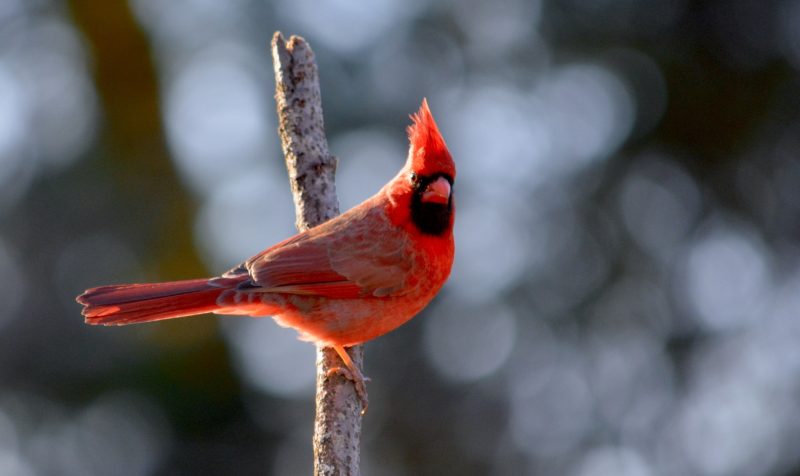In the heart of Indiana, where fields meet forests and the seasons shift in brilliant color, one bird stands as a symbol of beauty, resilience, and song—the Northern Cardinal. With its crimson feathers glowing against winter snow and its clear, whistling tune echoing through backyards, this bird has captured the hearts of Hoosiers for generations.
But behind its familiar appearance lies a deeper, more fascinating story. Cardinals are not just pretty songbirds—they’re highly intelligent, territorial, and symbolic creatures that have adapted perfectly to Indiana’s diverse climate. From their courtship behaviors to their year-round presence, these birds are full of surprises.
In this article, we’ll reveal the truth about cardinals in Indiana you didn’t know—exploring their habits, nesting, symbolism, and why their population continues to thrive while others struggle. Whether you’re a birdwatcher, nature lover, or simply someone who enjoys the sound of morning song, you’ll see the cardinal in a whole new light.
The Northern Cardinal: Indiana’s Signature Bird

A Beloved Symbol
The Northern Cardinal (Cardinalis cardinalis) holds a special place in Indiana’s natural and cultural heritage. It was officially named the state bird in 1933, admired for its year-round beauty and cheerful song.
Its bright red plumage and melodic call have made it a favorite among birdwatchers and artists alike. The cardinal is also the state bird of six other states, but Indiana’s snowy winters make the sight of its red feathers particularly striking.
Appearance and Identification
Male cardinals are unmistakable—brilliant red from head to tail with a black mask around the face and a pointed crest. Females, while less vibrant, possess a warm blend of tan, orange, and subtle red hues, which makes them just as stunning up close.
Both sexes have strong, cone-shaped orange beaks ideal for cracking seeds, and their expressive crests can rise or flatten depending on their mood—a clue to their emotions.
Distinctive Songs
Cardinals are known for their clear, whistling calls, often described as “cheer-cheer-cheer” or “birdie-birdie-birdie.” Unlike many songbirds, both males and females sing. This unique trait helps pairs communicate, defend their territory, and strengthen their bond.
Where Cardinals Thrive in Indiana
A Perfect Habitat
Indiana offers an ideal mix of habitats for cardinals: suburban neighborhoods, woodlands, farms, and forest edges. They prefer dense shrubs and small trees for nesting and feeding, often close to open spaces where they can easily spot predators.
Common habitats include:
- Backyard gardens and bird feeders
- Farmlands with hedgerows
- Urban parks and city neighborhoods
- Forest edges and river corridors
Year-Round Residents
Unlike migratory birds, cardinals stay in Indiana all year long. Their thick feathers and ability to fluff for insulation allow them to withstand harsh winters. Many people notice cardinals more in winter simply because their vivid color contrasts beautifully with snow-covered landscapes.
During cold months, they form small flocks—sometimes 10 to 20 birds—to share feeding areas and stay warm.
Diet and Feeding Behavior
What Cardinals Eat
Cardinals are omnivores, with a diet consisting of seeds, fruits, and insects. In Indiana, their favorite foods include:
- Sunflower and safflower seeds (especially at feeders)
- Corn and grains from farmlands
- Wild berries like dogwood and sumac
- Beetles, grasshoppers, and caterpillars during summer
Their strong beaks allow them to easily crack open tough seed shells, while their preference for fruit makes them important seed dispersers for native plants.
Feeding at Bird Feeders
In Indiana’s backyards, cardinals are frequent guests at bird feeders. They prefer:
- Platform feeders or hopper feeders where they can perch comfortably
- Seed mixes heavy in black oil sunflower or safflower
- Feeders placed near bushes for quick cover from predators
Homeowners often see cardinals visiting early in the morning and late in the evening—their preferred feeding times.
Breeding and Nesting Secrets
Courtship Rituals
Cardinals are monogamous and form strong pair bonds that can last for life. During courtship, males perform endearing gestures such as feeding seeds to females beak-to-beak, a behavior that symbolizes trust and affection.
Their songs also play a key role in romance. Males sing loudly to attract mates, while females respond with softer calls—creating a musical duet that strengthens their connection.
Building the Nest
Females take the lead in building the nest, usually in dense shrubs, vines, or small trees 3–10 feet off the ground. They use twigs, bark, leaves, and grasses to create a cup-shaped nest lined with fine roots or hair.
Eggs and Hatchlings
A typical clutch consists of 2 to 5 eggs, pale grayish-white with brown speckles. The female incubates them for 11–13 days, while the male stands guard and brings food.
Once hatched, the chicks are fed a diet rich in insects to promote rapid growth. Within 10 days, the young cardinals fledge and begin to explore under their parents’ watchful eyes.
Multiple Broods
In Indiana’s mild seasons, cardinals often raise two or even three broods per year, ensuring a steady population growth.
The Truth About Their Behavior
Territorial Defenders
Cardinals are fiercely territorial. Males often spend hours defending their space from rivals, sometimes even attacking their reflection in windows or mirrors—mistaking it for an intruder.
During breeding season, their aggression intensifies, especially near nesting areas. This protective instinct ensures the safety of their mates and offspring.
Adaptation to Human Environments
Cardinals have adapted remarkably well to suburban life. Unlike many birds that flee urbanization, cardinals thrive in human-altered landscapes filled with feeders, ornamental shrubs, and open lawns.
This adaptability is a key reason why their numbers remain strong across Indiana, even as other bird species decline.
Symbolism and Cultural Significance
The Spiritual Meaning of Cardinals
Throughout history, cardinals have been symbols of hope, renewal, and loved ones’ presence. In many cultures, a cardinal sighting is believed to represent a spiritual visit from someone who has passed away.
Their bright red color symbolizes vitality, love, and faith, while their year-round presence makes them a sign of constancy and endurance.
Cardinals in Indiana Culture
The bird’s influence extends into sports and art. Many Indiana schools and teams have adopted the cardinal as a mascot, representing pride, strength, and resilience—qualities that perfectly reflect the state’s spirit.
How to Attract Cardinals to Your Backyard
Provide the Right Food
Cardinals love sunflower seeds, cracked corn, and safflower seeds. Avoid tiny millet or mixed filler seeds, as they’re often ignored.
Offer Water Sources
A birdbath or shallow fountain attracts cardinals year-round, especially during dry summer months. Keep water fresh and clean to prevent disease.
Create Natural Shelter
Plant dense shrubs such as dogwood, viburnum, holly, or cedar. These provide nesting cover and safety from predators like hawks and cats.
Avoid Reflective Surfaces
To prevent territorial aggression, cover reflective windows near feeders with decals or screens during breeding season.
Keep Feeders Consistent
Cardinals are creatures of habit. Once they find a reliable food source, they return daily. Keeping feeders filled helps maintain a loyal flock.
Common Predators and Threats
Natural Predators
Cardinals face threats from:
- Snakes and squirrels, which raid nests
- Hawks and owls, their main avian predators
- Cats, both domestic and feral
To protect cardinals, avoid using pesticides that harm their insect food sources and keep outdoor cats indoors.
Weather Challenges
Harsh winters, while manageable, can still stress cardinals when food is scarce. Providing feeders during cold months greatly increases their survival rates.
Conservation and Population Trends
Stable Populations
Unlike many bird species, the Northern Cardinal population is thriving. Data from the North American Breeding Bird Survey shows that their numbers have increased steadily over the past 50 years.
This success is due to their adaptability, year-round residency, and human-friendly behavior. They’ve learned to coexist with people while maintaining their natural rhythms.
How You Can Help
Even though cardinals aren’t endangered, you can support them by:
- Planting native trees and shrubs
- Avoiding lawn chemicals
- Keeping birdbaths clean
- Participating in local bird counts and conservation programs
Every small effort contributes to a healthier environment for all Indiana birds.
Myths and Misconceptions About Cardinals
Myth |
Truth |
|---|---|
Only males sing. |
False. Female cardinals also sing, especially during nesting. |
Cardinals migrate south in winter. |
False. They stay in Indiana all year long. |
Seeing a cardinal brings bad luck. |
False. It’s considered a sign of good fortune or remembrance. |
Cardinals can’t live in cities. |
False. They thrive in suburban and urban environments. |
All red birds are cardinals. |
False. Other species, like the scarlet tanager, can be mistaken for them. |
Fascinating Facts About Indiana Cardinals
- Cardinals mate for life, though they may find new partners if one dies.
- They can live up to 15 years in the wild under ideal conditions.
- Their song dialects vary by region—Indiana cardinals sound slightly different from southern ones.
- They molt after breeding, temporarily losing their bright color before regrowing vivid feathers.
- Juvenile cardinals are brown with dark bills until they mature.
- Both parents feed chicks, showing remarkable teamwork.
- Their beaks can generate up to 300 psi of pressure to crack seeds.
- Cardinals were once rare in the northern U.S., but warming climates expanded their range northward.
FAQs About Cardinals in Indiana
Do cardinals stay in Indiana all year?
Yes. They are non-migratory and remain active even in freezing temperatures.
What’s the best way to attract them?
Offer sunflower seeds, provide fresh water, and plant dense shrubs for nesting.
Why do cardinals attack windows?
They mistake their reflection for a rival during breeding season.
Are cardinals endangered?
No. Their populations are stable and even growing across Indiana.
What do cardinal sightings mean spiritually?
Many people see them as signs of hope or visits from loved ones who’ve passed away.
Conclusion
The truth about cardinals in Indiana is that they’re far more than just beautiful birds—they are living symbols of loyalty, love, and perseverance. Their songs brighten Indiana mornings, their colors light up winter landscapes, and their resilience mirrors the spirit of the Hoosier State itself.
Whether perched on a snowy branch or flitting through a summer garden, the cardinal reminds us of nature’s simple wonders—how beauty, strength, and song can thrive in every season.
So, the next time you see that flash of red outside your window, pause and appreciate it. You’re not just looking at a bird—you’re witnessing one of Indiana’s most remarkable natural treasures, a winged emblem of life, love, and enduring grace.






